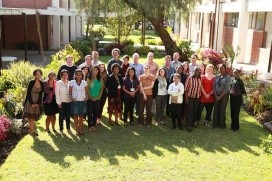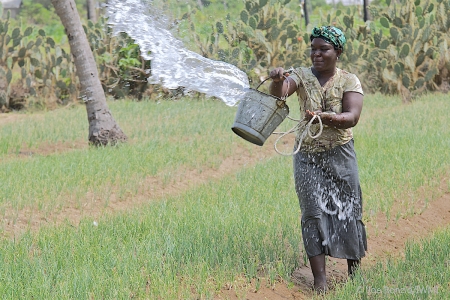Last month, the CGIAR Research Program on Livestock and Fish and the CGIAR Research Program on Water, Land and Ecosystems hosted a joint Communications Workshop entitled (concisely): Organizing, Managing, Communicating and Leveraging Information and Knowledge to Support and Deliver CRP Results: A hands-on Workshop on Approaches, Tools, Systems and Services
You can get a feel for the complexity of the communications field just by reading the title of our workshop! I was reminded during this workshop of why I was so interested in communications to begin with. Why I wanted to stray away from being a research student and venture into the communications field. I took this path to be on the other side of communications. I wanted to learn how to take research outputs and turn them into research outcomes, to work with researchers throughout the research process and see how research can affect change. The Aggregating and Reusing Knowledge workshop session explored ways in which we can "show the shop floor" and make our knowledge more accessible.
Behavior change
Simon Cook, Director of the CGIAR Research Program on Water, Land and Ecosystems (WLE), has made it very clear that behavior change is at the crux of achieving food security for our rising population. It’s becoming more and more apparent that behavior change is going to have to occur on a number of levels. First, we may need to start with the research institution itself. How are we conducting research? Where does the research process start and end? And how are we (as an institution) measuring and encouraging success?
Right now, within CGIAR (as with most research institutions), success is still largely measured by publications. This is not to discount the importance of publishing research. I recognize that through publications, scientists hope and expect their research will be used in other researchers’ work, furthering research innovations. While certainly necessary in the research world, we need to somehow add a few more hours in the day for researchers and extend this research process beyond the point of publication….that’s where communicators come in!
Communicators can be...
The field of communications goes far beyond managing publications, media coverage and press releases, which are what many typically think of when we talk about communications. Communicators can be facilitators, they can organize platforms for discussions across multiple stakeholders and actors, they can create communications tools that translate research outputs into materials that can be used on the ground.
These materials range from policy briefs to brochures to video or radio campaigns that can reach smallholder farmers. Communications can also find its way into the research process through participatory research—check out our participatory video and participatory radio sessions—and through internal communications tools, which are vital in a program with 14+ partners. (Please visit this page for the conference agenda and notes or visit the synthesis session here.)
Blurring boundaries
For years, researchers have been working to increase food production, minimize negative impacts on the environment, and improve the livelihoods of the rural poor. We, as communicators, have a role to play in this research. A new study by IDS finds that the roles of researchers and research communicators have recently begun to shift as boundaries between the two fields blur. We have to recognize this shift and newly found emphasis on communications as we move towards a 'research for development' and 'communications for development' agenda.
As the Challenge Program on Water and Food Communications Coordinator Michael Victor stressed, we need to first build a “Coalition of the Willing.” There has been some buy in from CGIAR centers and researchers and we hope to harness this type of energy as we move forward with our communications strategy. This blog site has been very successful in promoting research publications. We did a trial with Terry Clayton’s review of an IWMI publication: The Scalar Disconnect. In a period of less than 3 weeks, the publication received over 700 hits and made it to Taylor and Francis’ “Most Read Article” list.
This is just one example of the many ways in which communications teams can support and build upon research outputs. We welcome your comments on how communications can be used most effectively as a “research for development” tool. How do you think we can reach donors, partners, colleagues, and the end users of WLE research most effectively?








/index.jpg?itok=EzuBHOXY&c=feafd7f5ab7d60c363652d23929d0aee)









Comments
Hi. Here is another article on the role of communication in development. They identify three objectives: information provision, coalition building and behavior change. https://www.guardian.co.uk/global-development-professionals-network/adam-...
What i think is important is that we see the communication not as something that is 'done' after the project but something goes throughout the research process. Also that we should see communication as a discipline unto itself and not a support function. If we are ultimately about behavior change, we need to understand audiences and those we are working with or trying to change. There is a whole field of behavior change that CGIAR has not tapped into that could be utiilzed as to why people are making decisions and how we can influence. For too long the assumption was that if we make a bigger, better, higher yielding variety farmers will use it. Or if we provide the policy advice, someone will use it.
For those that want an overview of the 'whole field of behavior change that CGIAR has not tapped into', this book which reviews much of what has been done in the field of 'communication for rural innovation' could be interesting: https://onlinelibrary.wiley.com/doi/10.1002/9780470995235.fmatter/pdf
see also this summary article in the IDS bulletin special issue Abby referred to: https://onlinelibrary.wiley.com/doi/10.1111/j.1759-5436.2012.00363.x/abst...
This work also notes that individual behaviour change of farmers is not sufficient, but work at several levels in 'innovation systems' is needed.
Had a look at that link. I think the appeal of 5-7-12 step models is the promise of simplicity they offer. That's because real life is messy and fuzzy. As Abby points out, communications is a discipline. Here's a goood place to start learning about the discipline https://www.afirstlook.com/edition_7/theory_list
Very Nice! You put a nice twist to it. Well put Abby.